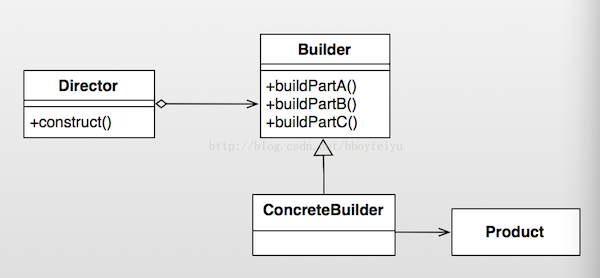1. 模式介绍
模式的定义
将一个复杂对象的构建与它的表示分离,使得同样的构建过程可以创建不同的表示。
模式的使用场景
- 相同的方法,不同的执行顺序,产生不同的事件结果时;
- 多个部件或零件,都可以装配到一个对象中,但是产生的运行结果又不相同时;
- 产品类非常复杂,或者产品类中的调用顺序不同产生了不同的效能,这个时候使用建造者模式非常合适;
2. UML类图

角色介绍
- Product 产品类 : 产品的抽象类。
- Builder : 抽象类, 规范产品的组建,一般是由子类实现具体的组件过程。
- ConcreteBuilder : 具体的构建器.
- Director : 统一组装过程(可省略)。
3. 模式的简单实现
简单实现的介绍
电脑的组装过程较为复杂,步骤繁多,但是顺序却是不固定的。下面我们以组装电脑为例来演示一下简单且经典的builder模式。
实现源码
package com.dp.example.builder;
/**
* Computer产品抽象类, 为了例子简单, 只列出这几个属性
*
* @author mrsimple
*
*/
public abstract class Computer {
protected int mCpuCore = 1;
protected int mRamSize = 0;
protected String mOs = "Dos";
protected Computer() {
}
// 设置CPU核心数
public abstract void setCPU(int core);
// 设置内存
public abstract void setRAM(int gb);
// 设置操作系统
public abstract void setOs(String os);
@Override
public String toString() {
return "Computer [mCpuCore=" + mCpuCore + ", mRamSize=" + mRamSize
+ ", mOs=" + mOs + "]";
}
}
package com.dp.example.builder;
/**
* Apple电脑
*/
public class AppleComputer extends Computer {
protected AppleComputer() {
}
@Override
public void setCPU(int core) {
mCpuCore = core;
}
@Override
public void setRAM(int gb) {
mRamSize = gb;
}
@Override
public void setOs(String os) {
mOs = os;
}
}
package com.dp.example.builder;
package com.dp.example.builder;
/**
* builder抽象类
*
*/
public abstract class Builder {
// 设置CPU核心数
public abstract void buildCPU(int core);
// 设置内存
public abstract void buildRAM(int gb);
// 设置操作系统
public abstract void buildOs(String os);
// 创建Computer
public abstract Computer create();
}
package com.dp.example.builder;
public class ApplePCBuilder extends Builder {
private Computer mApplePc = new AppleComputer();
@Override
public void buildCPU(int core) {
mApplePc.setCPU(core);
}
@Override
public void buildRAM(int gb) {
mApplePc.setRAM(gb);
}
@Override
public void buildOs(String os) {
mApplePc.setOs(os);
}
@Override
public Computer create() {
return mApplePc;
}
}
package com.dp.example.builder;
public class Director {
Builder mBuilder = null;
/**
*
* @param builder
*/
public Director(Builder builder) {
mBuilder = builder;
}
/**
* 构建对象
*
* @param cpu
* @param ram
* @param os
*/
public void construct(int cpu, int ram, String os) {
mBuilder.buildCPU(cpu);
mBuilder.buildRAM(ram);
mBuilder.buildOs(os);
}
}
/**
* 经典实现较为繁琐
*
* @author mrsimple
*
*/
public class Test {
public static void main(String[] args) {
// 构建器
Builder builder = new ApplePCBuilder();
// Director
Director pcDirector = new Director(builder);
// 封装构建过程, 4核, 内存2GB, Mac系统
pcDirector.construct(4, 2, "Mac OS X 10.9.1");
// 构建电脑, 输出相关信息
System.out.println("Computer Info : " + builder.create().toString());
}
}通过Builder来构建产品对象, 而Director封装了构建复杂产品对象对象的过程,不对外隐藏构建细节。
Android源码中的模式实现
在Android源码中,我们最常用到的Builder模式就是AlertDialog.Builder, 使用该Builder来构建复杂的AlertDialog对象。简单示例如下 :
//显示基本的AlertDialog
private void showDialog(Context context) {
AlertDialog.Builder builder = new AlertDialog.Builder(context);
builder.setIcon(R.drawable.icon);
builder.setTitle("Title");
builder.setMessage("Message");
builder.setPositiveButton("Button1",
new DialogInterface.OnClickListener() {
public void onClick(DialogInterface dialog, int whichButton) {
setTitle("点击了对话框上的Button1");
}
});
builder.setNeutralButton("Button2",
new DialogInterface.OnClickListener() {
public void onClick(DialogInterface dialog, int whichButton) {
setTitle("点击了对话框上的Button2");
}
});
builder.setNegativeButton("Button3",
new DialogInterface.OnClickListener() {
public void onClick(DialogInterface dialog, int whichButton) {
setTitle("点击了对话框上的Button3");
}
});
builder.create().show(); // 构建AlertDialog, 并且显示
} 结果 :
下面我们看看AlertDialog的相关源码 :
// AlertDialog
public class AlertDialog extends Dialog implements DialogInterface {
// Controller, 接受Builder成员变量P中的各个参数
private AlertController mAlert;
// 构造函数
protected AlertDialog(Context context, int theme) {
this(context, theme, true);
}
// 4 : 构造AlertDialog
AlertDialog(Context context, int theme, boolean createContextWrapper) {
super(context, resolveDialogTheme(context, theme), createContextWrapper);
mWindow.alwaysReadCloseOnTouchAttr();
mAlert = new AlertController(getContext(), this, getWindow());
}
// 实际上调用的是mAlert的setTitle方法
@Override
public void setTitle(CharSequence title) {
super.setTitle(title);
mAlert.setTitle(title);
}
// 实际上调用的是mAlert的setCustomTitle方法
public void setCustomTitle(View customTitleView) {
mAlert.setCustomTitle(customTitleView);
}
public void setMessage(CharSequence message) {
mAlert.setMessage(message);
}
// AlertDialog其他的代码省略
// ************ Builder为AlertDialog的内部类 *******************
public static class Builder {
// 1 : 存储AlertDialog的各个参数, 例如title, message, icon等.
private final AlertController.AlertParams P;
// 属性省略
/**
* Constructor using a context for this builder and the {@link AlertDialog} it creates.
*/
public Builder(Context context) {
this(context, resolveDialogTheme(context, 0));
}
public Builder(Context context, int theme) {
P = new AlertController.AlertParams(new ContextThemeWrapper(
context, resolveDialogTheme(context, theme)));
mTheme = theme;
}
// Builder的其他代码省略 ......
// 2 : 设置各种参数
public Builder setTitle(CharSequence title) {
P.mTitle = title;
return this;
}
public Builder setMessage(CharSequence message) {
P.mMessage = message;
return this;
}
public Builder setIcon(int iconId) {
P.mIconId = iconId;
return this;
}
public Builder setPositiveButton(CharSequence text, final OnClickListener listener) {
P.mPositiveButtonText = text;
P.mPositiveButtonListener = listener;
return this;
}
public Builder setView(View view) {
P.mView = view;
P.mViewSpacingSpecified = false;
return this;
}
// 3 : 构建AlertDialog, 传递参数
public AlertDialog create() {
// 调用new AlertDialog构造对象, 并且将参数传递个体AlertDialog
final AlertDialog dialog = new AlertDialog(P.mContext, mTheme, false);
// 5 : 将P中的参数应用的dialog中的mAlert对象中
P.apply(dialog.mAlert);
dialog.setCancelable(P.mCancelable);
if (P.mCancelable) {
dialog.setCanceledOnTouchOutside(true);
}
dialog.setOnCancelListener(P.mOnCancelListener);
if (P.mOnKeyListener != null) {
dialog.setOnKeyListener(P.mOnKeyListener);
}
return dialog;
}
}
}
可以看到,通过Builder来设置AlertDialog中的title, message, button等参数, 这些参数都存储在类型为AlertController.AlertParams的成员变量P中,AlertController.AlertParams中包含了与之对应的成员变量。在调用Builder类的create函数时才创建AlertDialog, 并且将Builder成员变量P中保存的参数应用到AlertDialog的mAlert对象中,即P.apply(dialog.mAlert)代码段。我们看看apply函数的实现 :
public void apply(AlertController dialog) {
if (mCustomTitleView != null) {
dialog.setCustomTitle(mCustomTitleView);
} else {
if (mTitle != null) {
dialog.setTitle(mTitle);
}
if (mIcon != null) {
dialog.setIcon(mIcon);
}
if (mIconId >= 0) {
dialog.setIcon(mIconId);
}
if (mIconAttrId > 0) {
dialog.setIcon(dialog.getIconAttributeResId(mIconAttrId));
}
}
if (mMessage != null) {
dialog.setMessage(mMessage);
}
if (mPositiveButtonText != null) {
dialog.setButton(DialogInterface.BUTTON_POSITIVE, mPositiveButtonText,
mPositiveButtonListener, null);
}
if (mNegativeButtonText != null) {
dialog.setButton(DialogInterface.BUTTON_NEGATIVE, mNegativeButtonText,
mNegativeButtonListener, null);
}
if (mNeutralButtonText != null) {
dialog.setButton(DialogInterface.BUTTON_NEUTRAL, mNeutralButtonText,
mNeutralButtonListener, null);
}
if (mForceInverseBackground) {
dialog.setInverseBackgroundForced(true);
}
// For a list, the client can either supply an array of items or an
// adapter or a cursor
if ((mItems != null) || (mCursor != null) || (mAdapter != null)) {
createListView(dialog);
}
if (mView != null) {
if (mViewSpacingSpecified) {
dialog.setView(mView, mViewSpacingLeft, mViewSpacingTop, mViewSpacingRight,
mViewSpacingBottom);
} else {
dialog.setView(mView);
}
}
}实际上就是把P中的参数挨个的设置到AlertController中, 也就是AlertDialog中的mAlert对象。从AlertDialog的各个setter方法中我们也可以看到,实际上也都是调用了mAlert对应的setter方法。在这里,Builder同时扮演了上文中提到的builder、ConcreteBuilder、Director的角色,简化了Builder模式的设计。
4. 杂谈
优点与缺点
优点
- 良好的封装性, 使用建造者模式可以使客户端不必知道产品内部组成的细节;
- 建造者独立,容易扩展;
- 在对象创建过程中会使用到系统中的一些其它对象,这些对象在产品对象的创建过程中不易得到。
缺点
- 会产生多余的Builder对象以及Director对象,消耗内存;
- 对象的构建过程暴露。
下载说明:
1、本站所有资源均从互联网上收集整理而来,仅供学习交流之用,因此不包含技术服务请大家谅解!
2、本站不提供任何实质性的付费和支付资源,所有需要积分下载的资源均为网站运营赞助费用或者线下劳务费用!
3、本站所有资源仅用于学习及研究使用,您必须在下载后的24小时内删除所下载资源,切勿用于商业用途,否则由此引发的法律纠纷及连带责任本站和发布者概不承担!
4、本站站内提供的所有可下载资源,本站保证未做任何负面改动(不包含修复bug和完善功能等正面优化或二次开发),但本站不保证资源的准确性、安全性和完整性,用户下载后自行斟酌,我们以交流学习为目的,并不是所有的源码都100%无错或无bug!如有链接无法下载、失效或广告,请联系客服处理!
5、本站资源除标明原创外均来自网络整理,版权归原作者或本站特约原创作者所有,如侵犯到您的合法权益,请立即告知本站,本站将及时予与删除并致以最深的歉意!
6、如果您也有好的资源或教程,您可以投稿发布,成功分享后有站币奖励和额外收入!
7、如果您喜欢该资源,请支持官方正版资源,以得到更好的正版服务!
8、请您认真阅读上述内容,注册本站用户或下载本站资源即您同意上述内容!
原文链接:https://www.dandroid.cn/18027,转载请注明出处。
1、本站所有资源均从互联网上收集整理而来,仅供学习交流之用,因此不包含技术服务请大家谅解!
2、本站不提供任何实质性的付费和支付资源,所有需要积分下载的资源均为网站运营赞助费用或者线下劳务费用!
3、本站所有资源仅用于学习及研究使用,您必须在下载后的24小时内删除所下载资源,切勿用于商业用途,否则由此引发的法律纠纷及连带责任本站和发布者概不承担!
4、本站站内提供的所有可下载资源,本站保证未做任何负面改动(不包含修复bug和完善功能等正面优化或二次开发),但本站不保证资源的准确性、安全性和完整性,用户下载后自行斟酌,我们以交流学习为目的,并不是所有的源码都100%无错或无bug!如有链接无法下载、失效或广告,请联系客服处理!
5、本站资源除标明原创外均来自网络整理,版权归原作者或本站特约原创作者所有,如侵犯到您的合法权益,请立即告知本站,本站将及时予与删除并致以最深的歉意!
6、如果您也有好的资源或教程,您可以投稿发布,成功分享后有站币奖励和额外收入!
7、如果您喜欢该资源,请支持官方正版资源,以得到更好的正版服务!
8、请您认真阅读上述内容,注册本站用户或下载本站资源即您同意上述内容!
原文链接:https://www.dandroid.cn/18027,转载请注明出处。





评论0